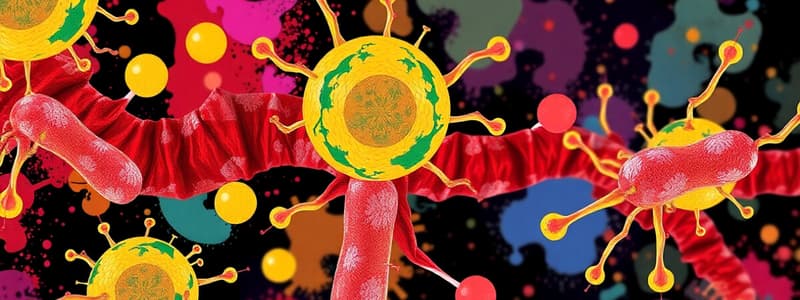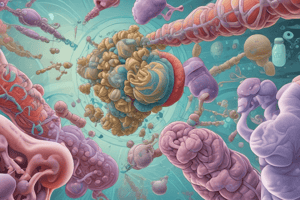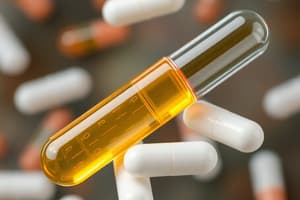Podcast
Questions and Answers
Which class of antibiotics works by inhibiting bacterial growth rather than killing bacteria immediately?
Which class of antibiotics works by inhibiting bacterial growth rather than killing bacteria immediately?
- Beta-lactams
- Aminoglycosides
- Tetracyclines (correct)
- Quinolones
What is the main purpose of clavulanic acid in the context of antibiotics?
What is the main purpose of clavulanic acid in the context of antibiotics?
- To increase bacterial resistance
- To act as an antimicrobial agent
- To inhibit beta-lactamase enzymes (correct)
- To enhance the efficacy of antifungal drugs
Which antibiotic is highlighted as being effective against Pseudomonas aeruginosa?
Which antibiotic is highlighted as being effective against Pseudomonas aeruginosa?
- Amoxycillin
- Gentamicin
- Carbenicillin (correct)
- Vancomycin
What characteristic is unique to aminoglycosides compared to other classes of antibiotics?
What characteristic is unique to aminoglycosides compared to other classes of antibiotics?
Which of the following antibiotics is specifically resistant to penicillinase?
Which of the following antibiotics is specifically resistant to penicillinase?
What is the primary mode of action of sulfonamides?
What is the primary mode of action of sulfonamides?
Which antibiotic is used primarily as a topical agent?
Which antibiotic is used primarily as a topical agent?
What type of bacterial infections can Gentamicin treat?
What type of bacterial infections can Gentamicin treat?
What is the primary action of antibiotics that inhibit RNA polymerase?
What is the primary action of antibiotics that inhibit RNA polymerase?
What is the reason for combining β lactams in treatment?
What is the reason for combining β lactams in treatment?
Which of the following is NOT a result of misusing antibiotics?
Which of the following is NOT a result of misusing antibiotics?
What is a characteristic of live, nonpathogenic bacteria in medical treatment?
What is a characteristic of live, nonpathogenic bacteria in medical treatment?
Which of the following factors contributes to the unresponsiveness of microorganisms to antibiotics?
Which of the following factors contributes to the unresponsiveness of microorganisms to antibiotics?
Which condition could potentially lead to serious complications when using probiotics?
Which condition could potentially lead to serious complications when using probiotics?
Which of the following is a method by which bacteria develop resistance to antibiotics?
Which of the following is a method by which bacteria develop resistance to antibiotics?
What type of infection is more likely to occur due to the emergence of multidrug-resistant bacteria?
What type of infection is more likely to occur due to the emergence of multidrug-resistant bacteria?
What is a primary reason for the use of combinations of antibiotics in treating polymicrobial infections?
What is a primary reason for the use of combinations of antibiotics in treating polymicrobial infections?
What is a potential consequence of incorrect antibiotic combinations in treatment?
What is a potential consequence of incorrect antibiotic combinations in treatment?
Which of the following mechanisms is NOT associated with the unresponsiveness of microorganisms to antibiotics?
Which of the following mechanisms is NOT associated with the unresponsiveness of microorganisms to antibiotics?
What characteristic allows penicillins to have selective toxicity against bacteria?
What characteristic allows penicillins to have selective toxicity against bacteria?
What describes the effect of live, nonpathogenic bacteria in treating diseases?
What describes the effect of live, nonpathogenic bacteria in treating diseases?
Which of the following classes of antibiotics includes compounds effective against MRSA?
Which of the following classes of antibiotics includes compounds effective against MRSA?
What is the outcome of the phenomenon of '1 + 1 = 0' in antibiotic therapy?
What is the outcome of the phenomenon of '1 + 1 = 0' in antibiotic therapy?
Which of the following is a common cause of multidrug resistance in bacteria?
Which of the following is a common cause of multidrug resistance in bacteria?
Which antibiotic can be described as both bactericidal and effective against Gram-positive bacteria?
Which antibiotic can be described as both bactericidal and effective against Gram-positive bacteria?
Which type of patients are particularly at risk of serious complications from probiotic use?
Which type of patients are particularly at risk of serious complications from probiotic use?
What is the primary role of beta-lactamases in bacterial resistance?
What is the primary role of beta-lactamases in bacterial resistance?
Which of the following antibiotics specifically targets DNA gyrase?
Which of the following antibiotics specifically targets DNA gyrase?
What is the term used to describe bacteria's ability to decrease antibiotic accumulation internally?
What is the term used to describe bacteria's ability to decrease antibiotic accumulation internally?
What type of bacteria is resistant to natural penicillins, necessitating the use of penicillinase-resistant alternatives?
What type of bacteria is resistant to natural penicillins, necessitating the use of penicillinase-resistant alternatives?
Which antibiotic example is primarily used in the treatment of urinary tract infections (UTIs)?
Which antibiotic example is primarily used in the treatment of urinary tract infections (UTIs)?
What is the function of compounds like clavulanic acid in antibiotic therapy?
What is the function of compounds like clavulanic acid in antibiotic therapy?
Flashcards
Antibiotics
Antibiotics
Naturally occurring or synthetic compounds that inhibit or destroy specific bacteria. These medications aim to selectively target bacteria while minimizing harm to the host.
Selective Toxicity
Selective Toxicity
The ability of a drug to harm a target organism without harming the host. This means antibiotics should primarily kill bacteria without damaging the human body.
Bactericidal vs. Bacteriostatic
Bactericidal vs. Bacteriostatic
Bactericidal antibiotics kill bacteria directly, while bacteriostatic antibiotics inhibit bacterial growth, eventually leading to their death.
Beta-Lactams
Beta-Lactams
Signup and view all the flashcards
Beta-Lactamase
Beta-Lactamase
Signup and view all the flashcards
Clavulanic Acid
Clavulanic Acid
Signup and view all the flashcards
Sulfonamides
Sulfonamides
Signup and view all the flashcards
Quinolones
Quinolones
Signup and view all the flashcards
Synergism
Synergism
Signup and view all the flashcards
Antagonism
Antagonism
Signup and view all the flashcards
Antibiotic Prophylaxis
Antibiotic Prophylaxis
Signup and view all the flashcards
Antimicrobial Resistance
Antimicrobial Resistance
Signup and view all the flashcards
What are some causes of antibiotic resistance?
What are some causes of antibiotic resistance?
Signup and view all the flashcards
What are some mechanisms of antibiotic resistance?
What are some mechanisms of antibiotic resistance?
Signup and view all the flashcards
Probiotics
Probiotics
Signup and view all the flashcards
What are some complications of probiotics?
What are some complications of probiotics?
Signup and view all the flashcards
What is the main mechanism of action of Rifampicin?
What is the main mechanism of action of Rifampicin?
Signup and view all the flashcards
What is synergism in antibiotics?
What is synergism in antibiotics?
Signup and view all the flashcards
What is antagonism in antibiotics?
What is antagonism in antibiotics?
Signup and view all the flashcards
What is antibiotic prophylaxis?
What is antibiotic prophylaxis?
Signup and view all the flashcards
What are probiotics?
What are probiotics?
Signup and view all the flashcards
What are some complications associated with probiotics?
What are some complications associated with probiotics?
Signup and view all the flashcards
Study Notes
Antimicrobial Definitions
- Antimicrobials: Naturally occurring or synthetically derived compounds that inhibit or destroy bacteria.
- Ideal Antibiotic: Shows selective toxicity, does not develop bacterial resistance, is non-allergenic, water-soluble, and stable with good tissue distribution.
- Bactericidal: Kill bacteria; examples include aminoglycosides, beta-lactams, vancomycin, quinolones, rifampin, and metronidazole.
- Bacteriostatic: Inhibit bacterial growth; examples include chloramphenicol, clindamycin, erythromycin, sulfonamides, trimethoprim, and tetracyclines.
- Antifungal: Targets fungi.
- Antiviral: Targets viruses.
- Antiprotozoal: Targets protozoa.
- Antihelminth: Targets parasitic worms.
Mechanisms of Action of Antibiotics
- Cell Wall Synthesis Inhibitors: Prevent the synthesis of peptidoglycans needed for the bacterial cell wall.
- Penicillins: Interfere with the synthesis of bacterial cell walls.
- Natural penicillins are effective against gram-positive cocci except Staphylococcus aureus.
- Penicillinase-resistant penicillins are effective against Staphylococci aureus.
- Extended-spectrum penicillins work against many gram-negative bacteria.
- Cephalosporins: Broad-spectrum antibiotics that work similarly to penicillins.
- Glycopeptides (Vancomycin): Important in treating methicillin-resistant Staphylococcus aureus (MRSA).
- Monobactam (Aztreonam): Specifically works on Pseudomonas aeruginosa.
- Carbapenems (Imipenem): Powerful drugs that are generally effective against gram-negative organisms, including Pseudomonas.
- Penicillins: Interfere with the synthesis of bacterial cell walls.
Inhibitors of Protein Synthesis
- 30S Inhibitors: Bind to the bacterial 30S ribosomal subunit, disrupting protein synthesis.
- Examples: Aminoglycosides (gentamicin, amikacin), Tetracyclines (oxytetracycline).
- 50S Inhibitors: Bind to the 50S ribosomal subunit, also disrupting protein synthesis.
- Examples: Macrolides (erythromycin), Chloramphenicol, Streptogramins (retapamulin).
Alteration of Cell Membrane Function
- Polymyxins: Topical antibiotics that disrupt the bacterial membrane.
- Daptomycin: Active against gram-positive bacteria, including MRSA and VRSA.
Inhibitors of Nucleic Acid Synthesis
- Co-trimoxazole: Treatment for urinary tract infections (UTIs). Combines sulphamethoxazole and trimethoprim.
- Quinolones (Ciprofloxacin, Levofloxacin): Inhibit DNA gyrase.
- Rifampicin: Inhibits RNA polymerase, inhibiting mRNA synthesis, and is used to treat tuberculosis.
Antimicrobial Combinations (Synergistic/Antagonistic)
- Additive Effects: Results in a sum of individual antimicrobial effects.
- Synergistic Effects: A combination of antimicrobials that produce a result better than that of the individual acting alone.
- Antagonistic Effects: A combination of antimicrobials that produce a result worse than that of the individual effect alone
Probiotics
- Live, nonpathogenic bacteria and/or yeasts used to treat or prevent diseases.
- Mechanisms: Exclude pathogens by colonizing the mucosa, enhance immune response, reduce inflammation, and treat antibiotic-associated diarrhea. Examples of probiotic foods: Yogurt, tempeh, sourdough, kimchi, kombucha, and sauerkraut.
Bacterial Resistance to Antibiotics & Failure of Treatment
- Misuse of Antibiotics Leading to emergence of multidrug-resistant bacteria including the following: MRSA, VRSA, and Pan-resistant Gram-negative bacteria.
- Causes for failure: Choice of antibiotic, inadequate dosage, or duration of treatment, route of antibiotic administration, or using antagonistic antibiotic combination.
- Bacterial resistance mechanisms: Reduction in intracellular antibiotic accumulation (decreasing permeability) or active efflux (efflux pumps) of the antibiotic. Enzymatic inactivation (inactivating enzymes) of antibiotics or alteration or inactivation of the target receptors of the antibiotic.
- Failure of antibiotic treatment can result from viral or mixed bacterial infection, inappropriate antibiotic choice, inadequate dosage, or treatment duration, incorrect administration route, or antagonistic antibiotic combinations.
- Misuse of antibiotics leads to the development of resistant strains, including multidrug-resistant (MDR) bacteria, which can cause life-threatening infections.
Clinical Case and Questions (Page 8)
- Clinical Case: A 45-year old female presenting with fever, burning urination, frequency, and dysuria; microbiological tests revealed gram-negative bacilli, Nitrofurantoin was prescribed.
- Inhibitors of protein synthesis: Tetracyclines, Aminoglycosides, Macrolides, Chloramphenicol
- Mechanisms of Antibiotic Resistance:
- Decreased permeability of the cell wall to the antibiotic.
- Active efflux pumps remove the antibiotic from the bacterial cell.
- Enzymatic inactivation of the antibiotic (e.g., inactivation of penicillins by β-lactamases).
- Modification of the bacterial target site (e.g., alteration of the ribosome preventing antibiotic binding).
Studying That Suits You
Use AI to generate personalized quizzes and flashcards to suit your learning preferences.





